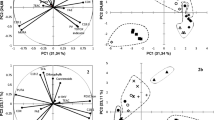Abstract
Seventeen argan oils from Swiss and German markets were evaluated regarding the sensory quality, identity, oxidative state as well as contaminants in order to give an overview about the characteristics of this high-value product on the market. At least one sensory defect was detected in each argan oil by a trained sensory panel showing that the sensory quality in most oils should be improved. Adulterations of expensive argan oil with cheaper oils are detectable by the dominant occurrence of γ-tocopherol and α-spinasterol and 7-stigmastenol (Schottenol) as characteristic Tocopherol and Phytosterols, respectively. Only one oil exceeded the limit of the total oxidation value (TOTOX) of 20; the shelf-life calculated from the induction period (Rancimat method at 120 °C) was 196–435 days. Some oils contained higher amounts of mineral oils while the content of Benzo[a]pyrene in all oils was remarkably below the limit of 2 µg/kg.






Similar content being viewed by others
References
Alimentarius C (2001) Codex Standard for Named Vegetable Oils CODEX STAN 210 (Amended 2003, 2005). Online: http://www.justice.gov.md/file/Centrul%20de%20armonizare%20a%20legislatiei/Baza%20de%20date/Materiale%202008/Legislatie/Codex%20STAN%20210.PDF
Anon (2009) Commission Regulation (EC) No 1151/2009 of November 27th 2009 imposing special conditions governing the import of sunflower oil originating in or consigned from Ukraine due to contamination risks by mineral oil and repealing Decision 2008/433/EC Off J Europ Union L 313/336–L 313/339
Anon (2011) Commission Regulation (EU) No 835/2011 of 19 August 2011 amending Regulation (EC) No 1881/2006 as regards maximum levels for polycyclic aromatic hydrocarbons in foodstuffs Off J Europ Union L 215/214–L 215/218
Charrouf Z, Guillaume D, Driouich A (2002) The Argan tree, an asset for Morocco. Biofutur 220:54–57
Charrouf Z, El Hamchi H, Mallia S, Licitra G, Guillaume D (2006) Influence of roasting and seed collection on argan oil odorant composition. Natural Product Commun 1(5):399–403
Charrouf Z, Harhar H, Gharby S, Guillaume D (2008) Enhancing the value of argan oil is the best mean to sustain the argan grove economy and biodiversity, so far. OCL Ol Corps Gras Lipides 15(4):269–274
DGF (2013) Deutsche Gesellschaft für Fettwissenschaft e. V.—Deutsche Einheitsmethoden zur Untersuchung von Fetten, Fettprodukten, Tensiden und verwandten Stoffen (2.Aufl.) Stuttgart: Wissenschaftliche Verlagsgesellschaft
Dubois V, Breton S, Linder M, Fanni J, Parmentier M (2007) Fatty acid profiles of 80 vegetable oils with regard to their nutritional potential. Eur J Lipid Sci Technol 109(7):710–732
EFSA (2008) Polycyclic aromatic hydrocarbons in food. Scientific opinion of the panel on contaminants in the food chain (Question N° EFSA-Q-2007-136) Adpt June 9th 2008
Frankel EN (2005) Methods to determine extent of oxidation. In: Frankel EN (ed) Lipid oxidation. The Oily Press, Dundee, pp 99–128
Geeraert E, Sandra P (1985) Capillary GC of triglycerides in fats and oils using a high temperature phenylmethylsilicone stationary phase, Part I. HRC CC. J High Resolut Chromatogr Commun 8:415–422
Hilali M, Charrouf Z, Aziz Soulhi AE, Hachimi L, Guillaume D (2005) Influence of origin and extraction method on argan oil physico-chemical characteristics and composition. J Agric Food Chem 53:2081–2087
ISO (2007) International Organization of Standardization. ISO 15302-2007—Animal and vegetable fats and oils—Determination of benzo[a]pyrene—Reverse-phase high performance liquid chromatographic method Geneva, Switzerland
Lebensmittelbuch (2011) Leitsätze für Speisefette und -öle. vom 3. November 2011 (BAnz. Nr.181 vom 1.12.2011, pp 4246)
Matthäus B, Guillaume D, Gharby S, Haddad A, Harhar H, Charrouf Z (2010) Effect of processing on the quality of edible argan oil. Food Chem 120:426–432
Maurin R, Fellatzarrouck K, Ksir M (1992) Positional analysis and determination of triacylglycerol structure of argania-spinosa seed oil. J Am Oil Chem Soc 69(2):141–145
Moret S, Barp L, Grob K, Conte LS (2011) Optimised off-line SPE-GC-FID method for the determination of mineral oil saturated hydrocarbons (MOSH) in vegetable oils. Food Chem 129(4):1898–1903
Ourrach I, Rada M, Perez-Camino MC, Benaissa M, Guinda A (2012) Detection of argan oil adulterated with vegetable oils: new markers. Grasas Aceites 63(4):355–364
Oussama A, Elabadi F, Devos O (2012) Analysis of argan oil adulteration using infrared spectroscopy. Spectrosc Lett 45(6):458–463
Pardun H (1976) Analyse der Nahrungsfette. P. Parey Verlag, Berlin, Hamburg
Rossell JB (1989) Measurement of rancidity (2 Aufl) London. Elsevier Applied Science, New York
Rutkowski A, Krygier K, Darzynkiewicz R (1977) Studies on analytics of frying fats. Lebensmittel Industrie 24(8):370–373
Tsaknis J, Spiliotis V, Lalas S, Gergis V, Dourtoglou V (1999) Quality changes of Moringa oleifera, variety Mbololo of Kenya, seed oil during frying. Grasas Aceites 50:37–48
Zeddelmann HV, Wurziger J (1973) Verhalten und Beurteilung von Fritierfetten in der Praxis. Fette Seifen Anstrichmittel 75:18–24
Author information
Authors and Affiliations
Corresponding author
Rights and permissions
About this article
Cite this article
Matthäus, B., Brühl, L. Quality parameters for the evaluation of cold-pressed edible argan oil. J. Verbr. Lebensm. 10, 143–154 (2015). https://doi.org/10.1007/s00003-014-0922-8
Received:
Accepted:
Published:
Issue Date:
DOI: https://doi.org/10.1007/s00003-014-0922-8




